The Fed, Stocks, and the Rocky Road Ahead
As the dust settles on the Federal Reserve’s first interest rate cut since 2020, the stock market has found itself on a roller…wait, no rollercoasters here. Instead, we’ll say it’s on a narrow path with a few hairpin turns ahead. The Dow Jones just hit a fresh record, closing above 42,000 for the first time ever. But now, the real test begins. With questions looming over whether we’ll see a hard landing, a soft landing, or no landing at all, investors are bracing for potential volatility over the next few months.
In this week’s issue of The Market Pulse, we’ll explore what’s next for the stock market following the Fed’s big move and how uncertainty surrounding inflation, jobs data, and the upcoming election could shape the market’s course. In our This Week I Learned section, you’ll learn why every economic data point will feel like a headline in the coming months. And of course, no newsletter is complete without a quick dose of fun, which brings us to today’s Fun Corner: a little market trivia to lighten the mood.
But before we dive into those segments, let’s focus on what’s driving this newfound stock market exuberance—and the “gut-wrenching” ride some investors are preparing for.
This Week I Learned…
When Market Data Becomes the Center of Attention
This week, I learned that in times of economic uncertainty, every little piece of economic data can make or break market sentiment. When the Federal Reserve cut rates by 50 basis points recently, investors responded by pushing stocks to new record highs. But now, all eyes are on the September and October jobs data, and the stakes are higher than ever.
In times of stability, small shifts in labor or inflation data are often shrugged off by the market. But when investors are uncertain, as they are now, every economic report becomes a potential market mover. In the next three months, each release—from employment figures to inflation updates—could spark sharp swings in market direction. Analysts have warned that, with the Fed expected to decide its next move in November, the margin for error is slim.
What’s the takeaway? In a market where investors are scrutinizing every report with a fine-tooth comb, expect a heightened sensitivity to each announcement. It’s no longer just about the big headlines—everything counts now. Prepare for a barrage of reactionary trading!
The Fun Corner
Twitter, Jobs Data, and the Unexpected Market Swing
Did you hear about the trader who started analyzing his barista’s latte art for market signals? Ok, that’s not quite true, but it might feel that way given how hypersensitive the market is to every piece of news right now. Whether it’s a tweet from a Fed official or an unexpected drop in unemployment, investors seem to be jumping at everything.
Speaking of hypersensitivity—did you know there’s a joke floating around about the Fed’s interest rate decisions? It goes: The Fed walks into a bar. Everyone gets excited and starts celebrating. Then the bartender says, “Sorry, folks, rates are only 50 basis points off.” The room goes silent. Such is the emotional journey the market is on.
Remember, during these next few months, it might be best to keep your analysis grounded—because not every tweet is a market predictor (or is it?).
Stock Investors Face a “Gut-Check” 3 Months Ahead
The U.S. stock market has just hit fresh records, with the Dow Jones closing above 42,000 for the first time ever. Investors were riding high after the Federal Reserve’s latest 50 basis-point rate cut, but many analysts now warn that the next three months could be turbulent. The debate surrounding whether the U.S. economy will face a hard landing, soft landing, or no landing at all is still in full swing, leaving investors bracing for potential market swings.
Keith Lerner, co-chief investment officer at Truist Advisory Services, believes that while the Fed’s rate cut was the right move, it has set the stage for heightened volatility. “There will definitely be some gut-checks and bumps along the way,” he warned. In the months ahead, the September and October jobs reports will take on even greater importance, as they could dictate the Fed’s next steps in November.
Additionally, while inflation fears have subsided somewhat, uncertainty remains. With job openings dwindling and unemployment creeping up, the risk of a recession still lingers in the background. However, Lerner remains cautiously optimistic, forecasting the S&P 500 could reach 6,000 by year-end, provided the labor market holds strong.
But the cautionary tone can’t be ignored. Recent months have shown that stocks have been reacting sharply to even minor economic data. Investors are on edge, watching every Fed signal and data release with newfound intensity. As we head into the final quarter of 2024, the market’s performance will hinge on how the economy responds to rate cuts, inflation data, and the looming presidential election.
The Last Say
Will We See a “Landing”?
As we look ahead, the next three months will be pivotal for the stock market. While stocks have reached new records, uncertainty remains about the path forward. Will the U.S. economy experience a hard landing, soft landing, or none at all? That question hangs over every major economic decision, from the Fed’s next rate moves to how investors will react to upcoming jobs reports.
The Fed’s 50 basis-point rate cut may have sparked new optimism, but as we’ve seen, investors are reacting strongly to even minor data points. With September and October jobs numbers and inflation updates taking center stage, the market could experience sharp swings before the year’s end.As always, staying informed and keeping a close eye on these developments will be key to navigating the market’s twists and turns. We’ll be here to guide you through, one data point at a time.

























